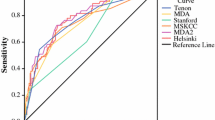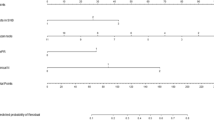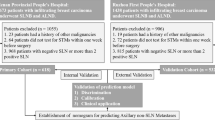Abstract
Although axillary lymph node dissection (ALND) has been the standard intervention in breast cancer patients with sentinel lymph node (SLN) metastasis, only a small proportion of patients benefit from this operation, because most do not harbor additional metastases in the axilla. Several predictive tools have been constructed to identify patients with low risk of non-SLN metastasis who could be candidates for the omission of ALND. In the present work, predictive nomograms were used to predict a high (>50 %) risk of non-SLN metastasis in order to identify patients who would most probably benefit from further axillary treatment. Data of 1000 breast cancer patients with SLN metastasis and completion ALND from 5 institutions were tested in 4 nomograms. A subset of 313 patients with micrometastatic SLNs were also tested in 3 different nomograms devised for the micrometastatic population (the high risk cut-off being 20 %). Patients with a high predicted risk of non-SLN metastasis had higher rates of metastasis in the non-SLNs than patients with low predicted risk. The positive predictive values of the nomograms ranged from 44 % to 64 % with relevant inter-institutional variability. The nomograms for micrometastatic SLNs performed much better in identifying patients with low risk of non-SLN involvement than in high-risk-patients; for the latter, the positive predictive values ranged from 13 % to 20 %. The nomograms show inter-institutional differences in their predictive values and behave differently in different settings. They are worse in identifying high risk patients than low-risk ones, creating a need for new predictive models to identify high-risk patients.
Similar content being viewed by others
References
Lyman GH, Giuliano AE, Somerfield MR et al (2005) American Society of Clinical Oncology guideline recommendations for sentinel lymph node biopsy in early-stage breast cancer. J Clin Oncol 23:7703–7720
Van Zee KJ, Manasseh DM, Bevilacqua JL et al (2003) A nomogram for predicting the likelihood of additional nodal metastases in breast cancer patients with a positive sentinel node biopsy. Ann Surg Oncol 10:1140–1151
Hwang RF, Krishnamurthy S, Hunt KK et al (2003) Clinicopathologic factors predicting involvement of nonsentinel axillary nodes in women with breast cancer. Ann Surg Oncol 10:248–254
Farshid G, Pradhan M, Kollias J, Gill PG (2004) A decision aid for predicting non-sentinel node involvement in women with breast cancer and at least one positive sentinel node. Breast 13:494–501
Barranger E, Coutant C, Flahault A, Antoine M, Darai E, Uzan S (2005) An axilla scoring system to predict non-sentinel lymph node status in breast cancer patients with sentinel lymph node involvement. Breast Cancer Res Treat 91:113–119
Degnim AC, Reynolds C, Pantvaidya G et al (2005) Nonsentinel node metastasis in breast cancer patients: assessment of an existing and a new predictive nomogram. Am J Surg 190:543–550
Chagpar AB, Scoggins CR, Martin RC 2nd et al (2006) Prediction of sentinel lymph node-only disease in women with invasive breast cancer. Am J Surg 192:882–887
Kohrt HE, Olshen RA, Bermas HR et al (2008) New models and online calculator for predicting non-sentinel lymph node status in sentinel lymph node positive breast cancer patients. BMC Cancer 8:66
Cho J, Han W, Lee JW et al (2008) A scoring system to predict nonsentinel lymph node status in breast cancer patients with metastatic sentinel lymph nodes: a comparison with other scoring systems. Ann Surg Oncol 15:2278–2286
Pal A, Provenzano E, Duffy SW, Pinder SE, Purushotham AD (2008) A model for predicting non-sentinel lymph node metastatic disease when the sentinel lymph node is positive. Br J Surg 95:302–309
Houvenaeghel G, Nos C, Giard S et al (2009) A nomogram predictive of non-sentinel lymph node involvement in breast cancer patients with a sentinel lymph node micrometastasis. Eur J Surg Oncol 35:690–695
Coufal O, Pavlík T, Fabian P et al (2009) Predicting non-sentinel lymph node status after positive sentinel biopsy in breast cancer: What model performs the best in a Czech population? Pathol Oncol Res 15:733–740
Perhavec A, Perme MP, Hocevar M, Besic N, Zgajnar J (2010) Ljubljana nomograms for predicting the likelihood of non-sentinel lymph node metastases in breast cancer patients with a positive sentinel lymph node. Breast Cancer Res Treat 119:357–366
Meretoja TJ, Strien L, Heikkilä PS, Leidenius MH (2012) A simple nomogram to evaluate the risk of nonsentinel node metastases in breast cancer patients with minimal sentinel node involvement. Ann Surg Oncol 19:567–576
Cserni G (2007) Comparison of different validation studies on the use of the Memorial-Sloan Kettering Cancer Center nomogram predicting nonsentinel node involvement in sentinel node positive breast cancer patients. Am J Surg 194:699–700
Bilimoria KY, Bentrem DJ, Hansen NM et al (2009) Comparison of sentinel lymph node biopsy alone and completion axillary lymph node dissection for node-positive breast cancer. J Clin Oncol 27:2946–2953
Yi M, Giordano SH, Meric-Bernstam F et al (2010) Trends in and outcomes from sentinel lymph node biopsy (SLNB) alone vs. SLNB with axillary lymph node dissection for node-positive breast cancer patients: experience from the SEER database. Ann Surg Oncol 17(Suppl 3):343–351
Giuliano AE, McCall L, Beitsch P et al (2010) Locoregional recurrence after sentinel lymph node dissection with or without axillary dissection in patients with sentinel lymph node metastasis. Ann Surg 252:426–433
Cserni G, Boross G, Maráz R et al (2012) Multicentre validation of different predictive tools of non-sentinel lymph node involvement in breast cancer. Surg Oncol. doi:10.1016/j.suronc.2011.12.001
Houvenaeghel G, Bannier M, Nos C et al (2012) Non sentinel node involvement prediction for sentinel node micrometastases in breast cancer: nomogram validation and comparison with other models. Breast 21:204–249
Cserni G, Gregori D, Merletti F et al (2004) Non-sentinel node metastases associated with micrometastatic sentinel nodes in breast cancer: metaanalysis of 25 studies. Br J Surg 91:1245–1252
Cserni G, Bori R, Sejben I et al (2009) Analysis of predictive tools for further axillary involvement in patients with sentinel-lymph-node-positive, small (< or =15 mm) invasive breast cancer. Orv Hetil 150:2182–2188
Goldhirsch A, Wood WC, Coates AS et al (2011) Strategies for subtypes—dealing with the diversity of breast cancer: highlights of the St Gallen International Expert Consensus on the Primary Therapy of Early Breast Cancer 2011. Ann Oncol 22:1736–1747
Tvedskov TF, Jensen MB, Lisse IM, Ejlertsen B, Balslev E, Kroman N (2012) High risk of non-sentinel node metastases in a group of breast cancer patients with micrometastases in the sentinel node. Int J Cancer. doi:10.1002/ijc.27499
Author information
Authors and Affiliations
Corresponding author
Rights and permissions
About this article
Cite this article
Cserni, G., Bori, R., Maráz, R. et al. Multi-Institutional Comparison of Non-sentinel Lymph Node Predictive Tools in Breast Cancer Patients with High Predicted Risk of Further Axillary Metastasis. Pathol. Oncol. Res. 19, 95–101 (2013). https://doi.org/10.1007/s12253-012-9553-5
Received:
Accepted:
Published:
Issue Date:
DOI: https://doi.org/10.1007/s12253-012-9553-5




